Erin Birden & Sheila Power
Region 15 Public Schools
TEACHER'S SNAPSHOT
Subjects:
Civic Engagement, Civics, Individuals in History, Politics & Government, Rights & Responsibilities of Citizens, World War II
Course Topics/Big Ideas:
Cultural Communities in Connecticut Present and Past
Town:
Southbury
Grade:
Grade 3
Lesson Plan Notes
In a democracy, individuals and communities can take informed action to stand up to injustice and prejudice. In this lesson, students will study the example set by the people and leaders of the town of Southbury, Connecticut, who used their voices and local government to stop the construction of a German American Bund Camp in their town. The German American Bund was a pro-Nazi American organization formed in 1936 and led by a man named Fritz Kuhn. They opened youth camps throughout the United States to spread the Nazi ideology. (Information is provided in the toolkit below to help you explain this using age-appropriate language and concepts.) In September 1937, a man named Wolfgang Jung, a member of the German American Bund, purchased 178 acres of land in Southbury with the goal of opening one of these youth camps. A small group of Southbury residents became aware of the sale. However, most people in the town of Southbury were unaware of the plans to build a youth camp until a newspaper article was published. Soon after, townspeople and leaders came together to use their voices and legal means to stop the camp from being built.
ESSENTIAL QUESTION
SUPPORTING QUESTIONS
- What makes people decide whether or not to stand up to injustice?
- What options did the Southbury community and its leaders have in responding to the German American Bund’s plan to build a camp in their town?
- What would you do if you saw something you thought was unjust, unfair, or wrong happening in your community?
ACTIVITY
- Open with a discussion of how individuals—both children and adults— react when faced with something they feel is wrong. What would you do if a friend tried to convince you to do something (or think something) that you felt was wrong? How would you respond? If this has happened to you, how did you respond? Do you wish you had responded differently? If so, why and in what way?
- Brainstorm ways people in a democracy—both individually and as a community—can respond to injustice. Be sure delve into students’ background knowledge and appropriately contextualize and explain the concepts of democracy (e.g. You may explain how a democracy is a type of government which relies on people’s responsible participation) and injustice (unfairness; consider layering in prejudice and discrimination, especially for the purposes of this lesson).
- Explain that today the class will be exploring something that really happened in Southbury, Connecticut, in 1937. (Contextualize the timeframe however works best for you and your students.)
- Students will read the abridged version of Lois’s Story by Ed Edelson. Either individually or as a class, go through the story to pull out the most important facts, words, and ideas. Who are the people involved in this story? How would you describe these people? Using just a word or phrase, what would you say this story is about? What did the different people in this story want? What did they do to try to achieve what they wanted?
- Next, students will examine four historical sources to help answer the question, “In what ways can a community in a democracy respond when faced with injustice?” Project and discuss the sources one at a time using the LOOK, THINK, WONDER technique or an analysis tool of your choice. Each of these sources illustrates one way that people in Southbury worked to prevent the German American Bund from building a camp in their town: preaching in church to spread the word; writing a letter to the editor of the newspaper to inform and try to convince other people; getting information out through a community newsletter; and participating in a public protest.
- Wrap up by discussing which of these methods students think might be most effective. What other ways could people stand up against injustice today? How can people convince other people to stand with them? What are the possible risks of standing up against something you feel is wrong? What are the benefits?
OPPORTUNITIES FOR ASSESSMENT
- Students will brainstorm a list of issues in their community that they feel are unfair and/or unjust. Selecting one of these, students will examine ways in which they could collectively respond and the benefits/costs of those choices. Students will plan and implement an agreed-upon action to address the issue they identified.
- Students will create a response to what they have learned about what happened in Southbury in 1937. Options include: creative/art response (e.g. drawing, word cloud, poem); student-led discussion groups; use of digital media tools, such as FlipGrid, etc.
RESOURCE TOOL KIT
A special thank you to Melinda Elliott of the Southbury Historical Society and Ben Sodergren of the Republican-American newspaper for helping locate and access the primary source documents.
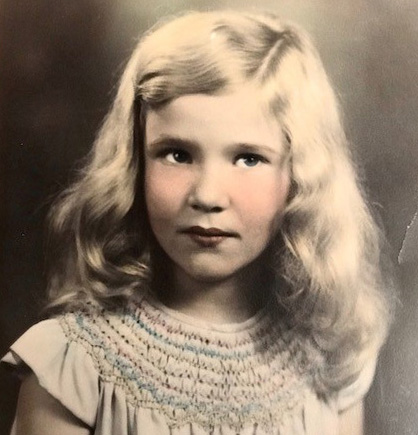
Lois’s Story, abridged by Ed Edelson 2022.
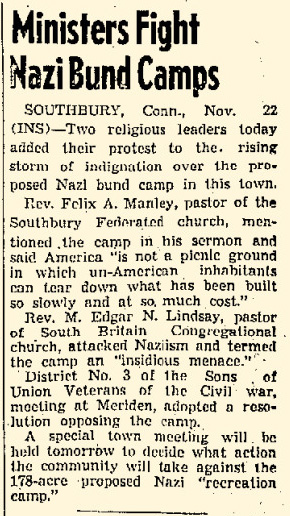
“Ministers Fight Nazi Bund Camps.” November 22, 1937. Courtesy: Southbury Historical Society.
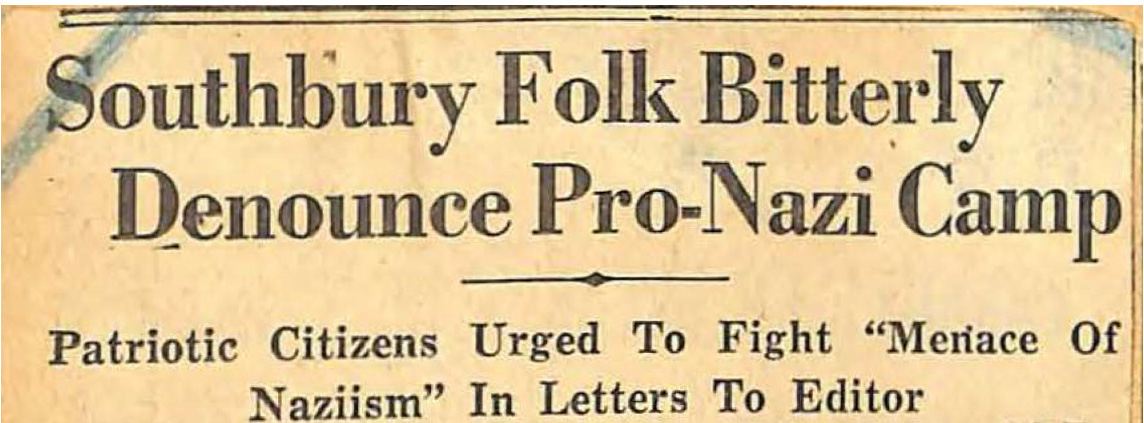
“Southbury Folk Bitterly Denounce Pro-Nazi Camp.” Waterbury Republican. November 18, 1937. Courtesy: Southbury Historical Society & Republican-American.
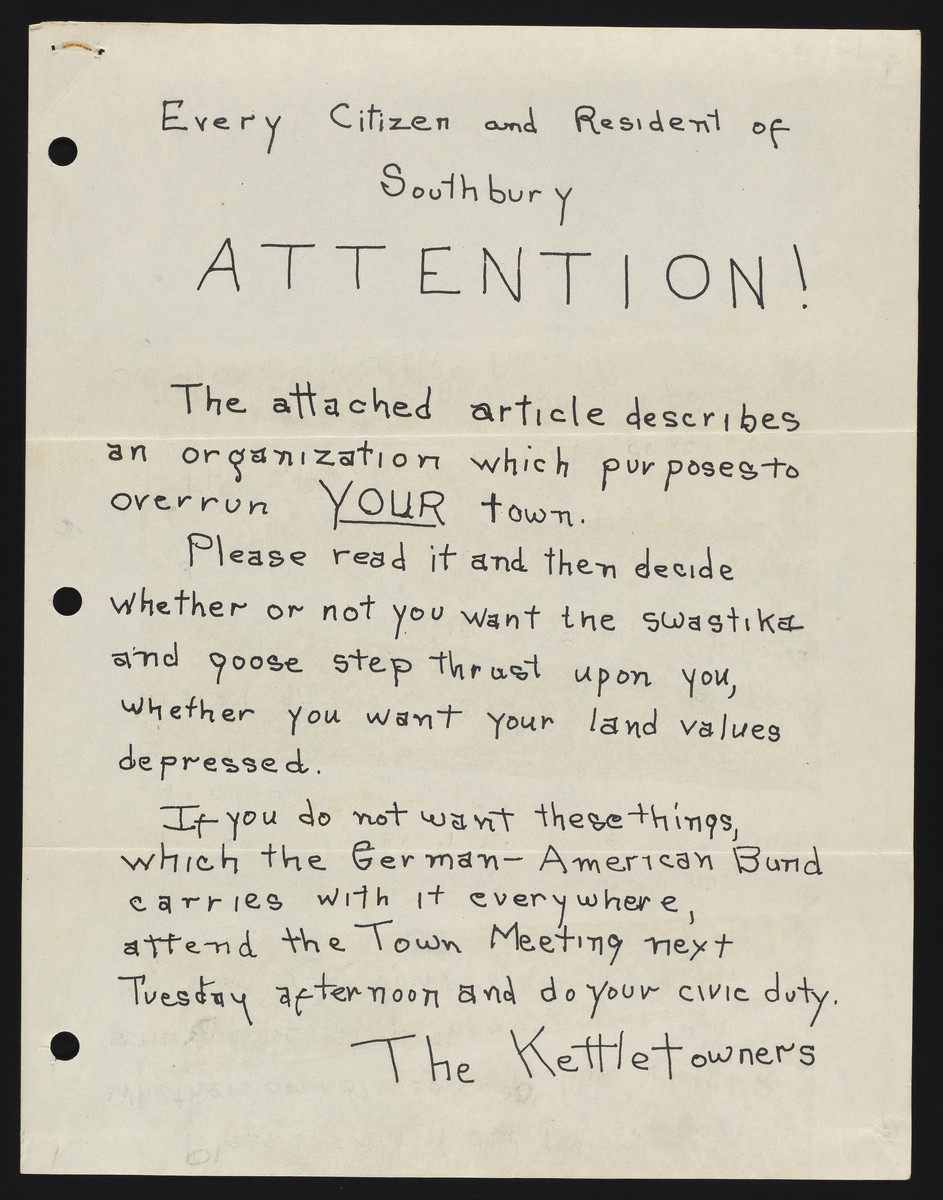
Kettletowners Flyer. Courtesy: Southbury Historical Society.
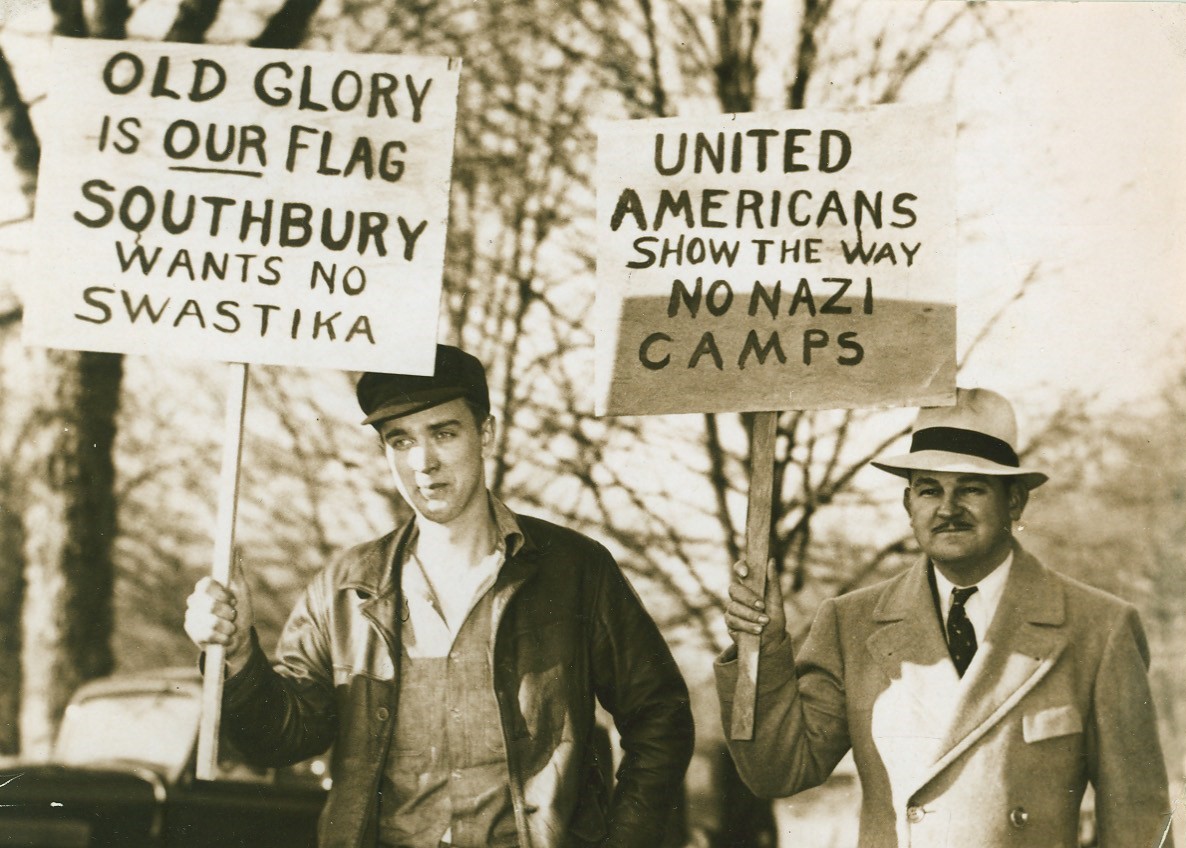
Ernest Moeller and Robert Harrison Protesting, photograph. Courtesy: Republican-American.

Tips for Discussing Nazism in a Developmentally Appropriate Way for Elementary Students.
ADDITIONAL RESOURCES
Places to GO
Southbury Historical Society, Southbury
Southbury Congregational Church, Southbury
Things To DO
Understand the timeline of the German American Bund in Southbury, Connecticut: Timeline for the Bund in Southbury by Melinda Elliott for the Southbury Historical Society.
Understand the context of the German American Bund in Connecticut and in the United States: Southbury in the 1930s by Melinda Elliott for the Southbury Historical Society.
Read Lois’s Story: A Young Girls Inspiration Helps Stop Hate and Fear by Ed Edelson, illustrated by Betty Ann Madeiros. Available to purchase here.
Listen to this podcast: How did a CT town take on the Nazis? from WSHU Public Radio
Watch the video in this Republican American article.
Watch this video from Museum of Jewish Heritage: Defiance in CT: “When Southbury Said No”
Websites to VISIT
Rev. Lindsay Papers (collection of letters sent to Rev. Lindsay), United States Holocaust Memorial Museum
Defiance in CT: “When Southbury Said No”, Museum of Jewish Heritage
How Southbury Kept a Nazi Camp out of Their Town, i95 Radio Station
84 years ago: Nazi Bund Camp was being Constructed in Southbury, Stopped by Brave Townspeople, i95 Radio Station
Americans and the Holocaust exhibit, United States Holocaust Memorial Museum
Articles to READ
“Southbury Takes on the Nazis.” ConnecticutHistory.org.
“Southbury’s defiance of Nazis in Holocaust Museum.” Alec Johnson.
Republican-American. April 29, 2018.
“How a Small Connecticut Town Fought the Nazis and Won.” Erik Ofgang. CT Insider: Connecticut Magazine. Nov. 22, 2018.
“New film portrays role of two YDS grads in keeping Nazis out of Southbury, CT in 1930s.” Sarah C. Ginolfi. Yale Divinity School News. December 1, 2012.
“How Southbury turned away the Nazis is chronicled in new documentary.” Daniela Forte, The Litchfield County Times. New Haven Register. Oct. 15, 2012.



